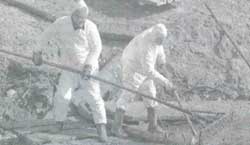Disaster down the pipe
 IT's happened again in Russia. On April 27, huge walls of fire enveloped a thick swath of uninhabited forest land after a 44-metre-long gas pipeline exploded in the Komi Republic, 1287.2 km north-east of Moscow. The pilot of a Japanese aircraft.flying over the inferno reported that the flames billowed as high as 7,600 metres. "It happens every week in Russia," says Alexander Shuvalov, spokesperson for Greenpeace International.
IT's happened again in Russia. On April 27, huge walls of fire enveloped a thick swath of uninhabited forest land after a 44-metre-long gas pipeline exploded in the Komi Republic, 1287.2 km north-east of Moscow. The pilot of a Japanese aircraft.flying over the inferno reported that the flames billowed as high as 7,600 metres. "It happens every week in Russia," says Alexander Shuvalov, spokesperson for Greenpeace International.
Gazprom, which owns the "disasterline", is finding it very hard to dispute Shuvalov. In Komi alone, 2,740 leaks were reported last year. Russian oil-workers are still struggling to clear the remnants of 100,000 tonnes of hot crude oil that spilled over and contaminated 69 hectares of delicate Arctic tundra near Usinsk, in Komi, last October.
The World Bank lent Russia us $99 million to help clear the mess. According to environmental NGOS operating in Russia, about 3/4th of Russia's oil pipelines were built more than 10 years ago, with 10 per cent more than 35 years old. Last week saw 2 major breaks in the national system, spewing out 198.9 cubic metres of crude oil in western Siberia's Tyumen region. fn Kazakhstan, a series of leaks in the Caspian Sea released more than 4972.5 cubic metres of crude. Inspectors discovered as many as 16 breaks. Gazprom is putting up a valiant defence. It says that almost all its pipelines are in acceptable condition. "It was the second such accident in the history of the national gas industry. The last one occurred 20 years ago," insisted Valery Remizov, deputy chairperson of the company. He also promised that the blast would not affect Russian gas exports, delivering 30 per cent of western Europe's natural gas.
